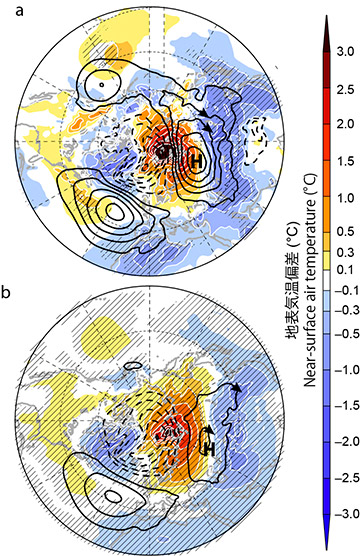Theme 5
Study on Arctic climate predictability

Anomalies of surface air temperature (SAT: shades) and sea level pressure (SLP: contours with 0.5 hPa interval and negative dashed) associated with the WACE pattern extracted by a singular value decomposition analysis for (a) ERA-Interim and (b) atmospheric model simulation. The hatching is for >95% statistical confidence for SAT anomalies.
The goal of this theme is to evaluate the predictability of Arctic-related climate variations, wherein we aim to: (1) establish the scientific basis of climate predictability; and (2) develop a method for predicting and projecting medium- and long-term climate variations.
In target (1), we carried out a study on the interaction among the multiple spheres that constitute the Arctic environment, such as atmosphere, ocean and cryosphere, as well as on the remote influence on climates outside the Arctic region. We demonstrated that the Arctic stratospheric response to sea ice changes and the climate memory through the land process play a crucial role in climate variability and its predictability. We also clarified the process of how Arctic climate is affected by the climates of areas far from the Arctic region, such as tropical areas and the southern hemisphere, and indicated the possibility of climate predictability based on the process, or on the other hand, the presence of factors that limit the predictability.
In the target (2), we conducted a study on seasonal to multi-decadal Arctic climate prediction utilizing climate models. We especially focused on sea ice processes and studied prediction of sea ice itself, atmospheric and oceanic processes affecting sea ice variabilit y, and sea ice response to, and roles in, climate warming. This study revealed that the predictability of the summer sea ice extent is associated with the durability (mass or volume) of sea ice in the Pacific sector of the Arctic Ocean. In addition, a basis for creating a dataset of sea ice thickness distribution, which is important for prediction but not yet sufficiently understood, was established by applying the methodology developed for seasonal sea-ice extent predictions.
Research background and overview
Please see here.
Research achievements
Please see here.




